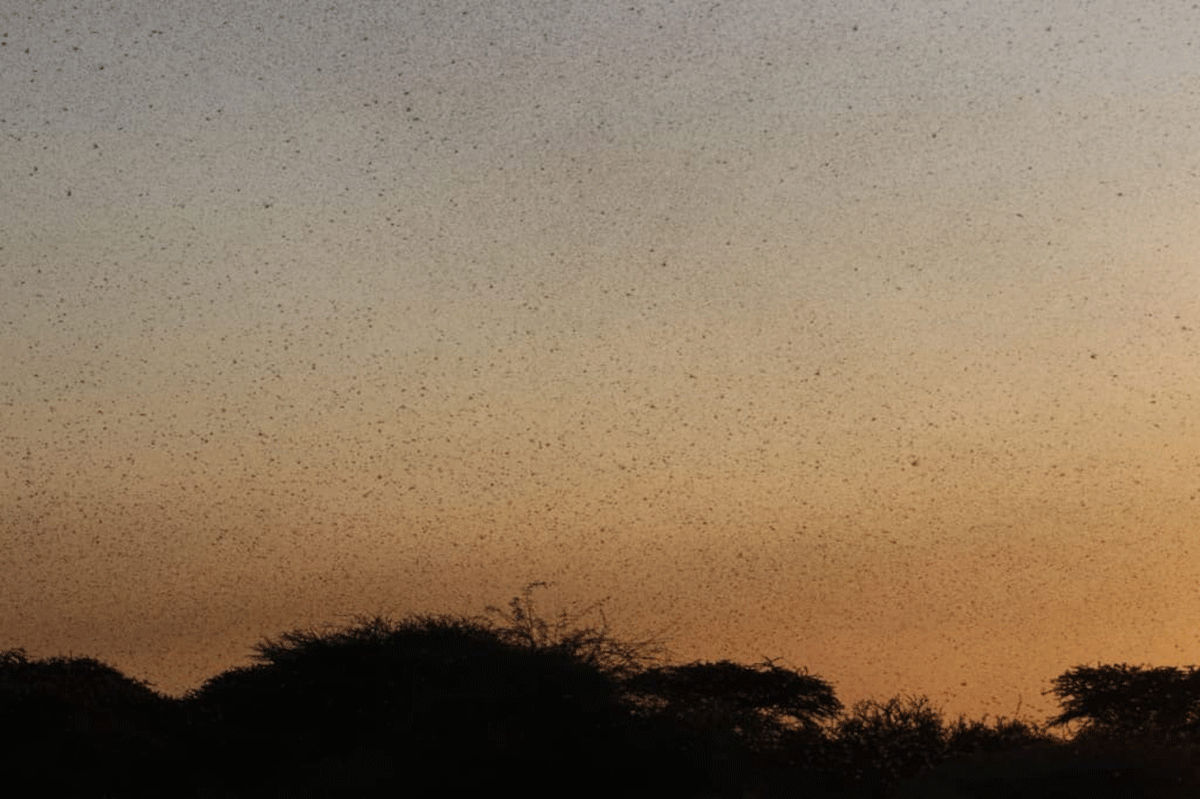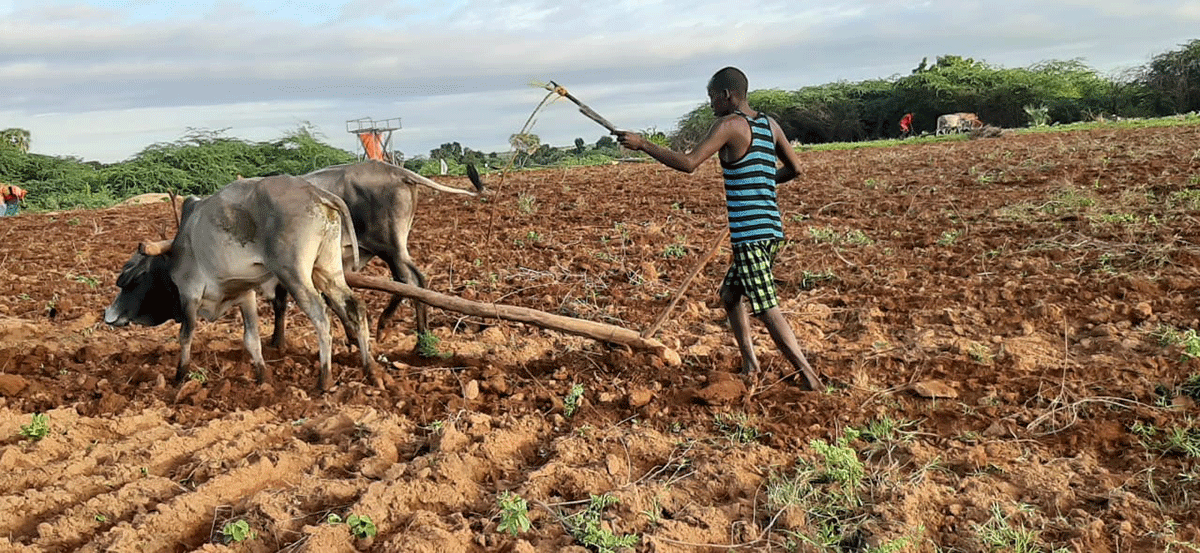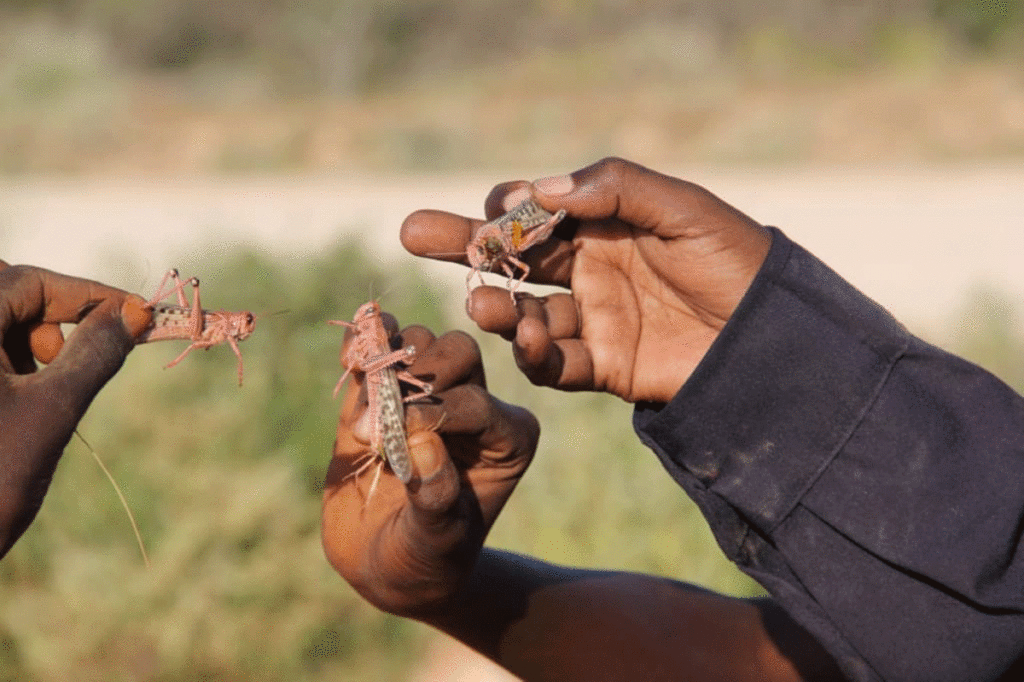Farmers in Mandera County have experienced several recurrent natural and man-made shocks including droughts, floods, diseases and conflicts that have had serious impact on their lives and livelihoods. Although not sufficient, the communities have over the years, acquired knowledge and strategies to cope with these shocks.
Early this year, the residents of the county witnessed and had to grapple with desert locust invasion. Most of the residents had not seen this problem in their entire lives and it caught them flatfooted. Not even the county authorities were prepared for the invasion. The locust which entered the county in swarms from the neighboring Somalia caused unprecedented havoc.
A team from BORESHA visited a farmer from one of the communities supported by the project to get information on the level of preparedness in case of another wave of invasion as well as assess the losses from the previous invasion. The team heads to Girisa location, 2KM north of Rhamu town where Issack Mahat, one of the project beneficiaries and a farmer, previously affected by locust invasion lives. After about three and a half minutes drive from Rhamu, the team arrives at his homestead. It is about 8:30AM and his home is already a beehive of activities. At the entrance, the team meets Abdirhaman, 16, one of the 3 sons of Mr. Issack with a wheelbarrow load of water in 20 liter jericans. We later learn that it was his day in the duty roster to fetch water from the nearby Aridzone Primary School. Like other villagers in the target areas, he easily recognized the BORESHA vehicle and the staff on board. It also appeared as though he was aware of our visit and he happily ushered us in, grinning from ear to ear. He led the team to a tree at the extreme end of the compound and where the family had literally rolled out a welcome mat. Other children too were up and about, doing different chores.

Issack’s homestead is a typical Somali homestead comprising of 3 Somali aqals (a dome-shaped collapsible traditional Somali shelter made from poles covered by woven fiber mats), goats pen fenced with thorny branches, a latrine, a raised rack where the family keeps fodder to feed the goats during lean periods, an open space in between the 3 aqals where children play the very many Somali traditional games for children including Aiy aiy, shabadan, seeman, footari, afar-gooli among others and a very well kept neem tree where Mr. Issack receives his guests. The tree actually serves as a drawing-room.
Mr. Issack gets out of one of the aqals dressed in a yellow sarung locally known as macawis, white shirts with a sheet over his shoulders, a hat and a pair of unpolished black open shoes. He quickly moves to our direction after having a word with one of his daughters. He greets the team with Islamic greetings and apologizes for the noise from the children adding that, “the schools are closed because of the disease (referring to COVID-19) and the children are all over the place”. Just as he concluded his statement, the daughter he was talking to, shows up with a flask full of tea and 3 iron cups locally known as “afliil or lixla or shakaba”. Mr. Issack is blessed with 11 children (8 girls and 3 boys) and also takes care of his elderly parents.
It is not a common practice for Somalis who have just met, to immediately get down to brass tacks and so we had to talk about current affairs, weather patterns, impact of devolved governance among other general and contextual issues before zeroing in on the locust menace.
We finally got down to business and Mr. Issack began painfully narrating the havoc caused by the desert locust during the last invasion as well as its secondary effects. He recounted, “The locust came in two phases. The first group of swarms were smaller in size, were less destructive and could easily be scared away and when scared they would go away or at least move to some distant place. It was fairly easy to deal with them. In the second phase however, swarms of bigger locust invaded the farms and were very destructive. When scared, they would not move. They would only hop a few meters away or from one plant to another. The locusts caused losses. All the lush green maize fields were reduced to hard stalks and all the efforts and resources incurred in that planting season went down the drain just like that in a matter of days. The same was the case in fields with other crops including fodder. Mango trees that have provided food and source of income for more than 30 years, were also seriously affected. Almost half of the mango trees in Girissa farms completely dried following the invasion. The forage in the rangelands were also not spared. The invasion and the resultant loses has therefore greatly affected food security in the location and the county at large especially considering that we were also hit by floods just as we were recovering from the locust invasion.
Farm products are not only consumed at household level but are also traded in the market and the proceeds are used to access health services, clothes the children, buy drugs for livestock, get schools fees and also buy other foods that are not locally produced but when there are yields, all these cannot be realized.”

When asked whether he has witnessed similar invasion in the past and whether the community received any support from the authorities and other actors, he say, “I have never, in my 53 years, seen this kind of a problem. The county government’s intervention was too little, came too late and ended as soon as it began. We employed simple methods such as beating of drums, shouting, hooting (using motorbikes), and lighting bonfire just to scare the insects away.”
When asked whether the community has fear of second wave of invasion and their level of preparedness, he retorts, “Personally, I am the chairman of the location’s DRR committee and my position in the committee and the community, requires me to be conscious and cognizant of what is happening or likely to happen and it is for this reason that I closely follow both local and international news to get apprised of what is happening. I have heard from the radio, that there’s likelihood of another invasion. We are people who rely and trust in God and we pray that we don’t see another locust invasion but as a committee, we are also trying to create awareness so that people do not heavily invest in planting of crops that may end up being destroyed by the locust. It is tricky because if we advise people not plant, there will be food security problems whether there will be invasion or not and if they plant and we witness another invasion, it will be a double loss, loss of invested money and loss of the planted crops. Other than awareness creation, there is nothing else we can do. Even the government is not prepared and we don’t expect much from them.
If there will be no proper and timely response to the invasion, it is going to be disastrous because the previous invasion caused food scarcity, which was compounded by the floods that followed and now COVID-19 and its restrictions that have exacerbated the situation. Another wave of invasion, especially if not well managed, is therefore going to have far reaching effects.”

